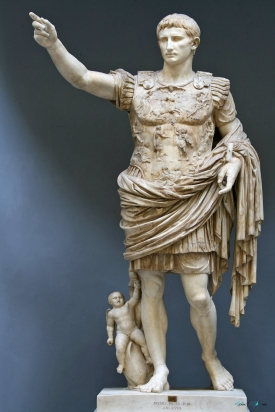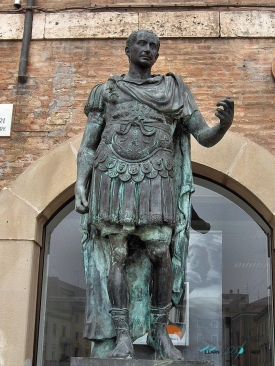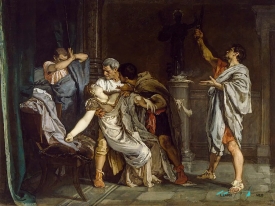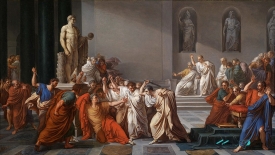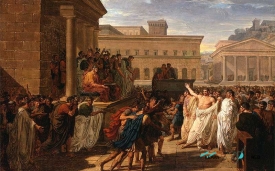When we talk about democracy, Athens immediately comes to mind as the birthplace of a system in which citizens choose who will govern them for a period of time—the opposite of a monarchy, where subjects have no say in government. However, Athenian democracy was short-lived. The true model of democracy and republicanism—though few associate it this way—was Rome. For five centuries, it was a Republic, from the expulsion of the last king in 509 B.C. to the concentration of power in the hands of Julius Caesar in the mid-1st century B.C.
This period is often praised as one of the earliest examples of a democratic government. But was Rome truly a democracy? And how did the ambitions of Julius Caesar weaken and ultimately dismantle that republican system after five centuries of existence? In this article, we explore the complex political system of the Roman Republic: its institutions, the power struggle between patricians and plebeians, its evolution and crises, and how it all led to the fall of the Republic once Caesar seized power. In the end, we reflect on whether this ancient story holds lessons for modern democracies.
The Roman Senate was the central deliberative body. Although in theory its decrees were “advice” (senatus consultum) and sovereignty resided with the people gathered in assemblies, in practice the Senate directed foreign policy, finance, and oversaw magistrates. At the beginning of the Republic, both the Senate and the consuls concentrated power almost entirely. Only patricians (members of the old aristocracy) could access high offices. However, the majority of the Roman population was plebeian—common citizens without noble titles—who soon began to demand participation and rights.
Over time, plebeians achieved more political victories. By the mid-4th century B.C., one of the two consuls could be of plebeian origin. Finally, in 287 B.C., the Hortensian Law decreed that the resolutions of the Assembly of the Plebs (plebiscita) would have the force of law for all citizens, without needing Senate approval. This milestone integrated the plebeian elite with the patrician class, forming a new mixed ruling class—the nobilitas—which would govern Rome for centuries to come.
Despite these reforms, Rome was never a complete democracy, either in participation or equality. Most magistrates were elected in the centuriate assemblies, organized into centuries of citizens based on wealth. The wealthiest held 98 centuries, giving their votes more weight than those of poorer citizens. In practice, this made elections a plutocracy dominated by elites: poor citizens often didn’t even vote, knowing their influence was minimal.
Furthermore, like in Athenian democracy, large portions of Roman society were excluded from politics: women, slaves, and foreigners had no civil rights or voting power. It is estimated that only about 10% of the population of Rome could vote in these assemblies.
That said, within its limitations, the republican system still gave a limited voice to the Roman people. Ordinary citizens could elect lower magistrates like aediles and quaestors, and vote on laws proposed by their tribunes. In other words, the people gathered in assemblies had real legislative power, something remarkable even today.
The tribunes of the plebs, meanwhile, had the sacred authority to veto almost any act of authority (except that of a dictator) if they believed it harmed the common citizen. Backed by the plebs, tribunes could paralyze politics and curb the nobles' most autocratic tendencies. This intricate balance of power—annual consuls, a lifelong Senate, popular assemblies, and watchful tribunes—allowed the Roman Republic to conquer the Mediterranean with its legions. It was an imperfect and often corrupt system, yes, but it laid the foundations for ideas of mixed government and citizen participation that inspire modern democracies.
Social tensions also intensified. The wars of conquest enriched the senatorial oligarchy, while many Roman farmers lost their land and joined the ranks of the urban poor or professional soldiers loyal more to their generals than to the state.
In 133 B.C., a revealing episode took place: Tribune Tiberius Gracchus proposed an agrarian reform law to redistribute public land to poor citizens. The Senate fiercely opposed it, and Tiberius was beaten to death by aristocratic supporters—setting a dark precedent of political violence in Rome. Years later, his brother Gaius Gracchus would also die trying to enact reforms.
Shortly after, General Gaius Marius allowed landless citizens to enlist in the army and promised rewards for veterans. This professionalized the legions but created armies more loyal to their leaders than to the Republic. In 88 B.C., General Lucius Cornelius Sulla marched on Rome—a shocking move—and became dictator. Though he eventually resigned, his example proved that republican checks could be broken by individual ambition.
In 49 B.C., he crossed the Rubicon River with his troops, defying the Senate. Thus began the Second Civil War. By 45 B.C., after defeating Pompey’s forces, Caesar was named dictator for life.
Though he avoided the title of king, he wielded absolute power. A group of 60 senators, including Brutus and Cassius, assassinated him on the Ides of March, March 15, 44 B.C.—but rather than restoring the Republic, they paved the way for empire.
Julius Caesar was not just a dictator—he was the product of a Republic that could no longer sustain itself. His rise exposed the cracks in the system, and his death sealed the fate of the republican model.
Do you think American democracy should look in the mirror of the Roman Republic?
This period is often praised as one of the earliest examples of a democratic government. But was Rome truly a democracy? And how did the ambitions of Julius Caesar weaken and ultimately dismantle that republican system after five centuries of existence? In this article, we explore the complex political system of the Roman Republic: its institutions, the power struggle between patricians and plebeians, its evolution and crises, and how it all led to the fall of the Republic once Caesar seized power. In the end, we reflect on whether this ancient story holds lessons for modern democracies.
A Unique Political System in Antiquity
After overthrowing the monarchy, the Romans established a republican form of government based on the concept of the res publica (“public affairs”). This system was a curious mix of monarchy, aristocracy, and democracy—as described by Greek historian Polybius in the 2nd century B.C. There were two consuls who exercised executive power jointly, with one-year terms—resembling monarchic authority but with strong limits. A powerful Senate, initially made up only of aristocratic patricians, advised and controlled much of political life, embodying an aristocratic element. Finally, the popular assemblies (comitia) allowed laws to be voted on and some magistrates to be elected, giving the people a voice and a democratic component. This political structure was the result of centuries of adaptation and social compromise.The Roman Senate was the central deliberative body. Although in theory its decrees were “advice” (senatus consultum) and sovereignty resided with the people gathered in assemblies, in practice the Senate directed foreign policy, finance, and oversaw magistrates. At the beginning of the Republic, both the Senate and the consuls concentrated power almost entirely. Only patricians (members of the old aristocracy) could access high offices. However, the majority of the Roman population was plebeian—common citizens without noble titles—who soon began to demand participation and rights.
Patricians vs. Plebeians: Social Conflict and Democratic Reforms
The early centuries of the Republic were marked by a power struggle between patricians and plebeians. Excluded from major offices and burdened by debt, the plebeians carried out several secessions (general strikes in which they left the city) as a means of pressure. These protests led to the creation of the Tribune of the Plebs in the early 5th century B.C.—a plebeian magistrate with the authority to veto decisions by the Senate or consuls that harmed the people.Over time, plebeians achieved more political victories. By the mid-4th century B.C., one of the two consuls could be of plebeian origin. Finally, in 287 B.C., the Hortensian Law decreed that the resolutions of the Assembly of the Plebs (plebiscita) would have the force of law for all citizens, without needing Senate approval. This milestone integrated the plebeian elite with the patrician class, forming a new mixed ruling class—the nobilitas—which would govern Rome for centuries to come.
Despite these reforms, Rome was never a complete democracy, either in participation or equality. Most magistrates were elected in the centuriate assemblies, organized into centuries of citizens based on wealth. The wealthiest held 98 centuries, giving their votes more weight than those of poorer citizens. In practice, this made elections a plutocracy dominated by elites: poor citizens often didn’t even vote, knowing their influence was minimal.
Furthermore, like in Athenian democracy, large portions of Roman society were excluded from politics: women, slaves, and foreigners had no civil rights or voting power. It is estimated that only about 10% of the population of Rome could vote in these assemblies.
That said, within its limitations, the republican system still gave a limited voice to the Roman people. Ordinary citizens could elect lower magistrates like aediles and quaestors, and vote on laws proposed by their tribunes. In other words, the people gathered in assemblies had real legislative power, something remarkable even today.
The tribunes of the plebs, meanwhile, had the sacred authority to veto almost any act of authority (except that of a dictator) if they believed it harmed the common citizen. Backed by the plebs, tribunes could paralyze politics and curb the nobles' most autocratic tendencies. This intricate balance of power—annual consuls, a lifelong Senate, popular assemblies, and watchful tribunes—allowed the Roman Republic to conquer the Mediterranean with its legions. It was an imperfect and often corrupt system, yes, but it laid the foundations for ideas of mixed government and citizen participation that inspire modern democracies.
Crisis of the Republic: Corruption and Civil Wars
By the 2nd–1st century B.C., the Roman Republic was beginning to show signs of crisis. Rome had expanded from an Italian city-state to a vast Mediterranean empire, straining its republican institutions. A system designed for a small polis now faced the challenge of governing distant provinces, immense wealth, and permanent armies.Social tensions also intensified. The wars of conquest enriched the senatorial oligarchy, while many Roman farmers lost their land and joined the ranks of the urban poor or professional soldiers loyal more to their generals than to the state.
In 133 B.C., a revealing episode took place: Tribune Tiberius Gracchus proposed an agrarian reform law to redistribute public land to poor citizens. The Senate fiercely opposed it, and Tiberius was beaten to death by aristocratic supporters—setting a dark precedent of political violence in Rome. Years later, his brother Gaius Gracchus would also die trying to enact reforms.
Shortly after, General Gaius Marius allowed landless citizens to enlist in the army and promised rewards for veterans. This professionalized the legions but created armies more loyal to their leaders than to the Republic. In 88 B.C., General Lucius Cornelius Sulla marched on Rome—a shocking move—and became dictator. Though he eventually resigned, his example proved that republican checks could be broken by individual ambition.
Julius Caesar: Unstoppable Rise and the Republic’s Fall
Julius Caesar came from an old patrician family in decline and aligned himself with the populares faction. He was nephew to Gaius Marius. In 60 B.C., he formed the First Triumvirate with Pompey and Crassus. After serving as consul and governing Gaul, Caesar amassed wealth and military loyalty.In 49 B.C., he crossed the Rubicon River with his troops, defying the Senate. Thus began the Second Civil War. By 45 B.C., after defeating Pompey’s forces, Caesar was named dictator for life.
Though he avoided the title of king, he wielded absolute power. A group of 60 senators, including Brutus and Cassius, assassinated him on the Ides of March, March 15, 44 B.C.—but rather than restoring the Republic, they paved the way for empire.
From Republican Dream to Imperial Rule
After Caesar’s death, Rome again plunged into civil war. His political heir, Octavian, defeated his rivals and became Augustus in 27 B.C., the first emperor. The Republic died with Caesar, giving rise to the Roman Empire.Legacy and Final Reflection
Was Rome a democracy? The Roman Republic established principles of elective, collegial, and balanced government, but it was never a full democracy. Power remained in elite hands, and citizen participation was limited and unequal. Even so, its legacy still shapes modern democratic ideals.Julius Caesar was not just a dictator—he was the product of a Republic that could no longer sustain itself. His rise exposed the cracks in the system, and his death sealed the fate of the republican model.
Do you think American democracy should look in the mirror of the Roman Republic?



